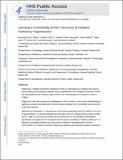Learning a Comorbidity-Driven Taxonomy of Pediatric Pulmonary Hypertension
Author(s)
Ong, Mei-Sing; Mullen, Mary P.; Austin, Eric D.; Szolovits, Peter; Natter, Marc D.; Geva, Alon; Cai, Tianxi; Kong, Sek Won; Mandl, Kenneth D.; ... Show more Show less
DownloadAccepted version (1.646Mb)
Terms of use
Metadata
Show full item recordAbstract
Rationale: Pediatric pulmonary hypertension (PH) is a heterogeneous condition with varying natural history and therapeutic response. Precise classification of PH subtypes is, therefore, crucial for individualizing care. However, gaps remain in our understanding of the spectrum of PH in children. Objective: We seek to study the manifestations of PH in children and to assess the feasibility of applying a network-based approach to discern disease subtypes from comorbidity data recorded in longitudinal data sets. Methods and Results: A retrospective cohort study comprising 6 943 263 children (<18 years of age) enrolled in a commercial health insurance plan in the United States, between January 2010 and May 2013. A total of 1583 (0.02%) children met the criteria for PH. We identified comorbidities significantly associated with PH compared with the general population of children without PH. A Bayesian comorbidity network was constructed to model the interdependencies of these comorbidities, and network-clustering analysis was applied to derive disease subtypes comprising subgraphs of highly connected comorbid conditions. A total of 186 comorbidities were found to be significantly associated with PH. Network analysis of comorbidity patterns captured most of the major PH subtypes with known pathological basis defined by the World Health Organization and Panama classifications. The analysis further identified many subtypes documented in only a few case studies, including rare subtypes associated with several well-described genetic syndromes. Conclusions: Application of network science to model comorbidity patterns recorded in longitudinal data sets can facilitate the discovery of disease subtypes. Our analysis relearned established subtypes, thus validating the approach, and identified rare subtypes that are difficult to discern through clinical observations, providing impetus for deeper investigation of the disease subtypes that will enrich current disease classifications. Keywords: cluster analysis; hypertension, pulmonary; comorbidity; pediatrics; connective tissue disease
Date issued
2017-06Department
Massachusetts Institute of Technology. Computer Science and Artificial Intelligence LaboratoryJournal
Circulation Research
Publisher
Ovid Technologies (Wolters Kluwer Health)
Citation
Ong, Mei-Sing et al. "Learning a Comorbidity-Driven Taxonomy of Pediatric Pulmonary Hypertension." Circulation Research 121, 4 (June 2017): 341-353 © 2017 American Heart Association, Inc
Version: Author's final manuscript
ISSN
0009-7330
1524-4571